
Illustrative Math Alignment: Grade 6 Unit 2
Introducing Ratios
Lesson 6: Introducing Double Number Line Diagrams
Use the following Media4Math resources with this Illustrative Math lesson.
| Thumbnail Image | Title | Body | Curriculum Topic |
|---|---|---|---|
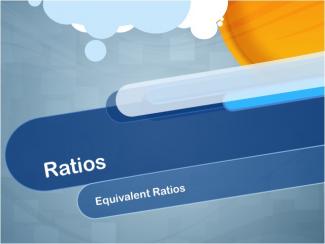
|
Closed Captioned Video: Ratios: Equivalent Ratios |
Closed Captioned Video: Ratios: Equivalent RatiosTopicRatios DescriptionThis video explains generating and comparing equivalent ratios. Examples include simplifying fractions, determining similarity in geometric shapes, and integrating multiple ratios into a comprehensive ratio. Applications extend to geometry and proportional reasoning. |
Ratios and Rates |
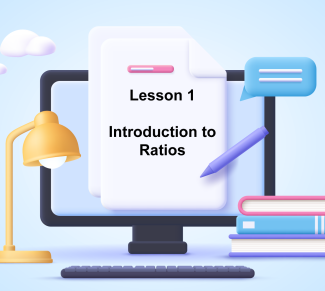
|
Lesson Plan--Ratios, Proportions, and Percents (Gr 6)--Lesson 1--Introduction to Ratios |
Lesson Plan: Introduction to Ratios In this foundational lesson, students embark on a journey to understand the concept of ratios, a crucial building block in mathematics that compares two or more quantities. Through engaging activities and practical examples, learners will: |
Ratios and Rates |
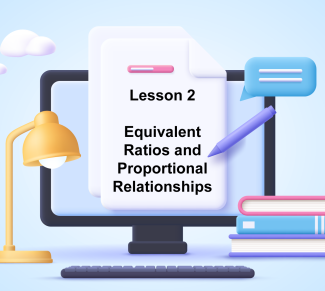
|
Lesson Plan--Ratios, Proportions, and Percents (Gr 6)--Lesson 2--Equivalent Ratios and Proportional Relationships |
Lesson Plan: Equivalent Ratios and Proportional Relationships In this lesson, students will deepen their understanding of equivalent ratios and their role in proportional reasoning. By exploring real-world applications, students will develop the skills to recognize, create, and use equivalent ratios in practical situations. The lesson introduces multiple strategies for working with equivalent ratios, including ratio tables, scaling up and down, and solving problems using proportional reasoning. Key components of this lesson include: |
Ratios and Rates and Applications of Ratios, Proportions, and Percents |
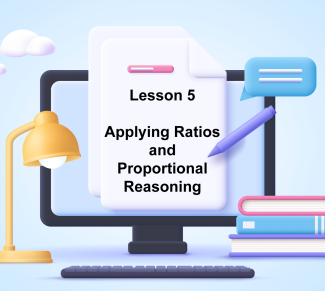
|
Lesson Plan--Ratios, Proportions, and Percents (Gr 6)--Lesson 5--Applying Ratios and Proportional Reasoning |
Lesson Plan: Applying Ratios and Proportional Reasoning This lesson plan is designed to provide sixth-grade students with a comprehensive understanding of ratios, proportions, and percents. Through engaging activities, hands-on explorations, and real-world applications, learners develop essential skills in comparing quantities, scaling figures up or down, and converting between fractions, decimals, and percents. This lesson emphasizes critical thinking and problem-solving strategies that help students apply mathematical reasoning to everyday situations, such as adjusting recipes, budgeting, and analyzing data. Key topics covered in this lesson include: |
Applications of Ratios, Proportions, and Percents |
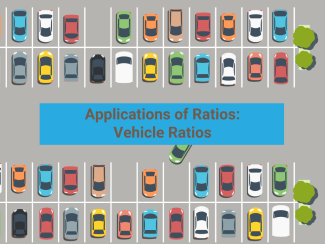
|
Math Clip Art--Applications of Equivalent Ratios--Vehicle Ratios 1 |
Math Clip Art--Applications of Equivalent Ratios--Vehicle Ratios 1TopicRatios DescriptionThis math clip art image is a title card for a series of math clip art images that apply equivalent ratios problems. The subsequent images show different vehicle ratios. This image, along with the overall collection, can be used to teach ratios by comparing the number of cars to other vehicle types or parking spaces. Teachers can use this visual to introduce the concept of part-to-whole ratios, such as the ratio of cars to total vehicles, or part-to-part ratios, like comparing the number of cars to motorcycles or SUVs in subsequent images. |
Ratios and Rates |

|
Math Clip Art--Applications of Equivalent Ratios--Vehicle Ratios 10 |
Math Clip Art--Applications of Equivalent Ratios--Vehicle Ratios 10TopicRatios DescriptionThis math clip art image displays a table with two rows labeled "Motorcycles" and "SUVs". The numbers in the table are 1, 2, 3, 4, 5 for Motorcycles and 2, 4, 6, 8, 10 for SUVs. This visual representation is crucial for teaching the concept of equivalent ratios using a different set of vehicles. |
Ratios and Rates |

|
Math Clip Art--Applications of Equivalent Ratios--Vehicle Ratios 2 |
Math Clip Art--Applications of Equivalent Ratios--Vehicle Ratios 2TopicRatios DescriptionThis math clip art image showcases a red car in a parking garage with numbered pillars in the background. The caption "40 Cars" provides context for the ratio concept being illustrated. This image is part of a series designed to teach equivalent ratios using vehicles as a relatable subject matter. |
Ratios and Rates |

|
Math Clip Art--Applications of Equivalent Ratios--Vehicle Ratios 3 |
Math Clip Art--Applications of Equivalent Ratios--Vehicle Ratios 3TopicRatios DescriptionThis math clip art image depicts a red motorcycle in a parking garage with numbered pillars in the background. The caption "10 Motorcycles" provides essential information for understanding ratios in the context of vehicles. This image is part of a series designed to teach equivalent ratios using different types of vehicles. |
Ratios and Rates |

|
Math Clip Art--Applications of Equivalent Ratios--Vehicle Ratios 6 |
Math Clip Art--Applications of Equivalent Ratios--Vehicle Ratios 6TopicRatios DescriptionThis math clip art image presents a table showing equivalent ratios of cars to motorcycles. The table displays five pairs of values: 4:1, 8:2, 12:3, 16:4, and 20:5. This visual representation is instrumental in teaching the concept of equivalent ratios and how they scale up while maintaining the same proportional relationship. |
Ratios and Rates |
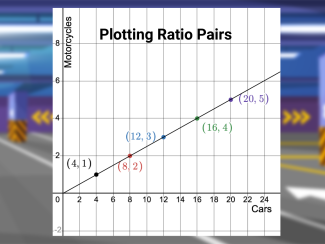
|
Math Clip Art--Applications of Equivalent Ratios--Vehicle Ratios 8 |
Math Clip Art--Applications of Equivalent Ratios--Vehicle Ratios 8TopicRatios DescriptionThis math clip art image presents another graph plotting the same ratio pairs as before, but with a line connecting them to show the linear relationship. This visual representation is crucial for teaching the concept of equivalent ratios and their graphical interpretation in a more comprehensive manner. |
Ratios and Rates |
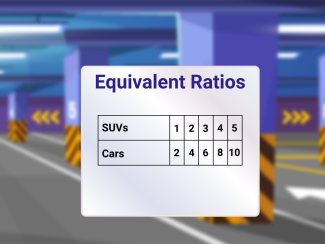
|
Math Clip Art--Applications of Equivalent Ratios--Vehicle Ratios 9 |
Math Clip Art--Applications of Equivalent Ratios--Vehicle Ratios 9TopicRatios DescriptionThis math clip art image presents a table with two rows labeled "SUVs" and "Cars". The numbers in the table are 1, 2, 3, 4, 5 for SUVs and 2, 4, 6, 8, 10 for Cars. This visual representation is essential for teaching the concept of equivalent ratios in a tabular format. |
Ratios and Rates |

|
Math Clip Art--Equivalent Ratios: Cooking 1 |
Math Clip Art--Equivalent Ratios: Cooking 1TopicRatios DescriptionThis math clip art image serves as a title card for a series on equivalent ratios in cooking. It features a decorative design with the title "Equivalent Recipes" along with illustrations of flour and various kitchen utensils. This visual introduction is crucial for setting the context and engaging students in the upcoming lesson on ratios in a practical, real-world scenario. |
Ratios and Rates |

|
Math Clip Art--Equivalent Ratios: Cooking 2 |
Math Clip Art--Equivalent Ratios: Cooking 2TopicRatios DescriptionThis math clip art image shows an illustration of two measuring cups: one containing 3/4 cup of milk and another with 1/2 cup of oil. This visual representation is crucial for introducing the concept of ratios in a practical, cooking-related context. The image effectively demonstrates how ratios can be represented using real-world measurements. By showing two different ingredients in specific quantities, it helps students visualize the concept of comparing two quantities. This concrete representation can make the abstract concept of ratios more tangible and easier to understand. |
Ratios and Rates |
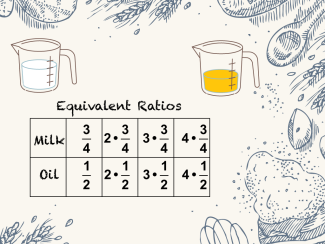
|
Math Clip Art--Equivalent Ratios: Cooking 3 |
Math Clip Art--Equivalent Ratios: Cooking 3TopicRatios DescriptionThis math clip art image presents a table of equivalent ratios for milk and oil, multiplying both quantities by 2, 3, and 4. This visual representation is essential for teaching the concept of equivalent ratios and scaling recipes. |
Ratios and Rates |
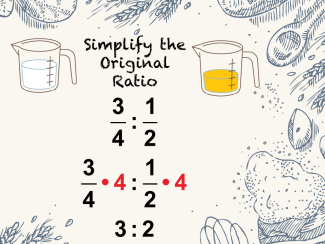
|
Math Clip Art--Equivalent Ratios: Cooking 4 |
Math Clip Art--Equivalent Ratios: Cooking 4TopicRatios DescriptionThis math clip art image illustrates the process of simplifying ratios in a cooking context. It shows the steps to simplify the original ratio of milk to oil from 3/4 : 1/2 to 3 : 2 by multiplying both terms by 4. This visual representation helps students understand how equivalent ratios work and how they can be simplified to their most basic form. |
Ratios and Rates |

|
Math Clip Art--Equivalent Ratios: Cooking 5 |
Math Clip Art--Equivalent Ratios: Cooking 5TopicRatios DescriptionThis math clip art presents a ratio table with illustrations of measuring cups containing milk and oil, displaying whole number ratios. The image effectively demonstrates how whole number ratios are scaled-up versions of the original recipe, making it easier for students to visualize and understand the concept of equivalent ratios in a practical context. |
Ratios and Rates |

|
Math Clip Art--Equivalent Ratios: Cooking 6 |
Math Clip Art--Equivalent Ratios: Cooking 6TopicRatios DescriptionThis math clip art image visually represents a 3:2 ratio using measuring cups filled with milk and oil. It shows three full cups of milk alongside two full cups of oil, illustrating that this ratio is four times the original recipe. This concrete representation helps students understand how equivalent ratios work in real-world contexts, particularly in cooking scenarios. |
Ratios and Rates |
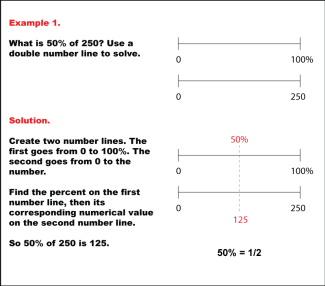
|
Math Example: Percents with Double Number Lines: Example 1 |
Math Example: Percents with Double Number Lines: Example 1TopicRatios, Proportions, Percents DescriptionThis example demonstrates how to find 50% of 250 using a double number line. The solution shows two parallel number lines: one ranging from 0 to 100% and the other from 0 to 250. By aligning 50% on the percentage line with its corresponding value on the numerical line, we can see that 50% of 250 is 125. This method visually represents the concept that 50% is equivalent to one-half of a quantity. |
Ratios and Rates |

|
Math Example: Percents with Double Number Lines: Example 10 |
Math Example: Percents with Double Number Lines: Example 10TopicRatios, Proportions, Percents DescriptionThis example demonstrates how to determine an unknown value using a double number line when given a part and its corresponding percentage, involving a decimal percentage. The image shows two number lines: one ranging from 0 to 100% and another from 0 to an unknown number x. The position 70 is marked on the second line, visually illustrating the process of finding x when 70 is 12.5% of x. |
Ratios and Rates |
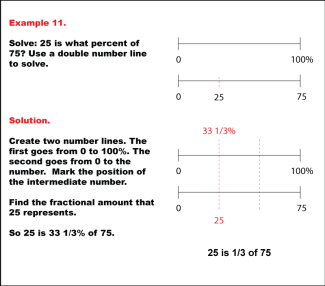
|
Math Example: Percents with Double Number Lines: Example 11 |
Math Example: Percents with Double Number Lines: Example 11TopicRatios, Proportions, Percents DescriptionThis example demonstrates how to determine what percent one number is of another using a double number line. The image shows two parallel number lines: one ranging from 0 to 100% and another from 0 to 75, with 25 marked as an intermediate point. This visual representation helps students understand the relationship between the part (25) and the whole (75) in percentage terms. |
Ratios and Rates |
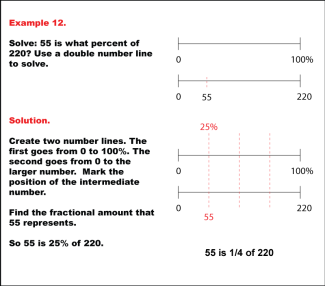
|
Math Example: Percents with Double Number Lines: Example 12 |
Math Example: Percents with Double Number Lines: Example 12TopicRatios, Proportions, Percents DescriptionThis example illustrates how to calculate what percent one number is of another using a double number line. The image depicts two parallel number lines: one spanning from 0 to 100% and another from 0 to 220, with 55 marked as an intermediate point. This visual representation helps students understand the relationship between the part (55) and the whole (220) in percentage terms. |
Ratios and Rates |
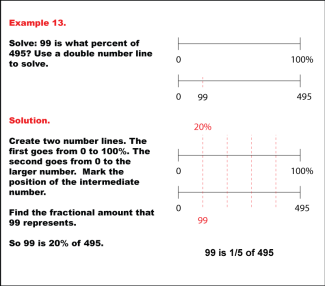
|
Math Example: Percents with Double Number Lines: Example 13 |
Math Example: Percents with Double Number Lines: Example 13TopicRatios, Proportions, Percents DescriptionThis example demonstrates how to determine what percent one number is of another using a double number line. The image shows two parallel number lines: one ranging from 0 to 100% and another from 0 to 495, with 99 marked as an intermediate point. This visual representation helps students understand the relationship between the part (99) and the whole (495) in percentage terms. |
Ratios and Rates |
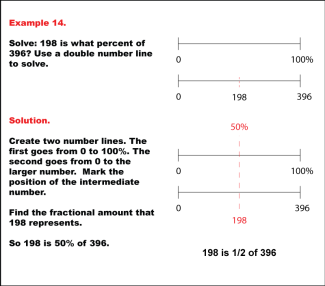
|
Math Example: Percents with Double Number Lines: Example 14 |
Math Example: Percents with Double Number Lines: Example 14TopicRatios, Proportions, Percents DescriptionThis example illustrates how to calculate what percent one number is of another using a double number line. The image depicts two parallel number lines: one spanning from 0 to 100% and another from 0 to 396, with 198 marked at the midpoint. This visual representation helps students understand the relationship between the part (198) and the whole (396) in percentage terms. |
Ratios and Rates |
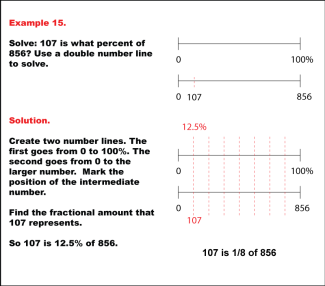
|
Math Example: Percents with Double Number Lines: Example 15 |
Math Example: Percents with Double Number Lines: Example 15TopicRatios, Proportions, Percents DescriptionThis example demonstrates how to determine what percent one number is of another using a double number line, particularly when dealing with more complex ratios. The image shows two parallel number lines: one ranging from 0 to 100% and another from 0 to 856, with 107 marked at an eighth of the way. This visual representation helps students understand the relationship between the part (107) and the whole (856) in percentage terms. |
Ratios and Rates |
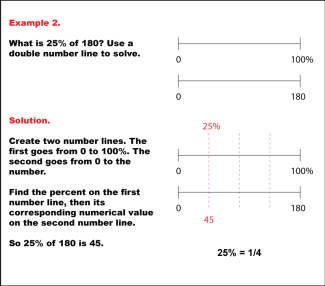
|
Math Example: Percents with Double Number Lines: Example 2 |
Math Example: Percents with Double Number Lines: Example 2TopicRatios, Proportions, Percents DescriptionThis example illustrates how to calculate 25% of 180 using a double number line. The solution presents two parallel number lines: one spanning from 0 to 100% and the other from 0 to 180. By aligning 25% on the percentage line with its corresponding value on the numerical line, we can determine that 25% of 180 is 45. This method visually demonstrates that 25% is equivalent to one-quarter of a quantity. |
Ratios and Rates |
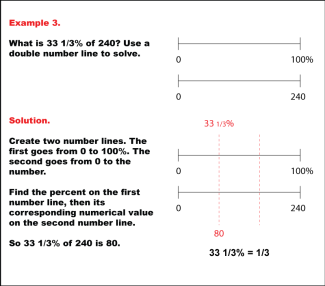
|
Math Example: Percents with Double Number Lines: Example 3 |
Math Example: Percents with Double Number Lines: Example 3TopicRatios, Proportions, Percents DescriptionThis example demonstrates how to find 33 1/3% of 240 using a double number line. The solution displays two parallel number lines: one ranging from 0 to 100% and the other from 0 to 240. By aligning 33 1/3% on the percentage line with its corresponding value on the numerical line, we can see that 33 1/3% of 240 is 80. This method visually represents the concept that 33 1/3% is equivalent to one-third of a quantity. |
Ratios and Rates |
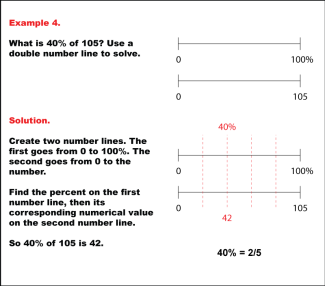
|
Math Example: Percents with Double Number Lines: Example 4 |
Math Example: Percents with Double Number Lines: Example 4TopicRatios, Proportions, Percents DescriptionThis example illustrates how to calculate 40% of 105 using a double number line. The solution presents two parallel number lines: one spanning from 0 to 100% and the other from 0 to 105. By aligning 40% on the percentage line with its corresponding value on the numerical line, we can determine that 40% of 105 is 42. This method visually demonstrates that 40% is equivalent to two-fifths of a quantity. |
Ratios and Rates |
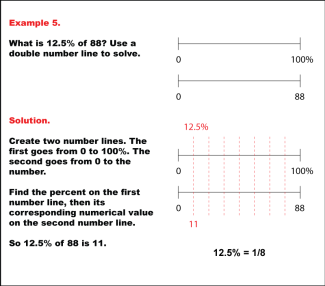
|
Math Example: Percents with Double Number Lines: Example 5 |
Math Example: Percents with Double Number Lines: Example 5TopicRatios, Proportions, Percents DescriptionThis example demonstrates how to find 12.5% of 88 using a double number line. The solution shows two parallel number lines: one ranging from 0 to 100% and the other from 0 to 88. By aligning 12.5% on the percentage line with its corresponding value on the numerical line, we can see that 12.5% of 88 is 11. This method visually represents the concept that 12.5% is equivalent to one-eighth of a quantity. |
Ratios and Rates |

|
Math Example: Percents with Double Number Lines: Example 6 |
Math Example: Percents with Double Number Lines: Example 6TopicRatios, Proportions, Percents DescriptionThis example demonstrates how to solve for an unknown value using a double number line when given a percentage. The image features two parallel number lines: one ranging from 0 to 100% and another from 0 to an unknown value x. It visually illustrates the process of determining x when 75 is 50% of x. |
Ratios and Rates |
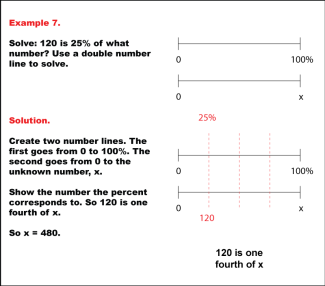
|
Math Example: Percents with Double Number Lines: Example 7 |
Math Example: Percents with Double Number Lines: Example 7TopicRatios, Proportions, Percents DescriptionThis example illustrates how to determine an unknown value using a double number line when given a part and its corresponding percentage. The image depicts two parallel number lines: one spanning from 0 to 100% and another from 0 to an unknown value x. It visually demonstrates the process of finding x when 120 is 25% of x. |
Ratios and Rates |
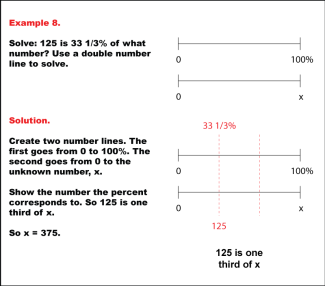
|
Math Example: Percents with Double Number Lines: Example 8 |
Math Example: Percents with Double Number Lines: Example 8TopicRatios, Proportions, Percents DescriptionThis example demonstrates how to find an unknown value using a double number line when given a part and its corresponding percentage, involving a fractional percentage. The image shows two parallel number lines: one ranging from 0 to 100% and another from 0 to an unknown value x. It visually illustrates the process of determining x when 125 is 33 1/3% of x. |
Ratios and Rates |
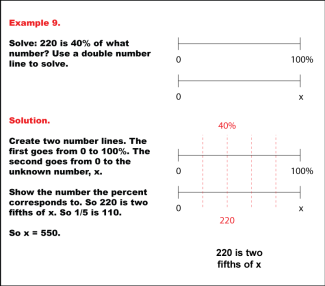
|
Math Example: Percents with Double Number Lines: Example 9 |
Math Example: Percents with Double Number Lines: Example 9TopicRatios, Proportions, Percents DescriptionThis example illustrates how to solve for an unknown value using a double number line when given a part and its corresponding percentage. The image shows two horizontal number lines: the top line ranges from 0 to 100%, and the bottom line ranges from 0 to an unknown number x. The 40% mark on the top line aligns with 220 on the bottom line, visually demonstrating the process of finding x when 220 is 40% of x. |
Ratios and Rates |
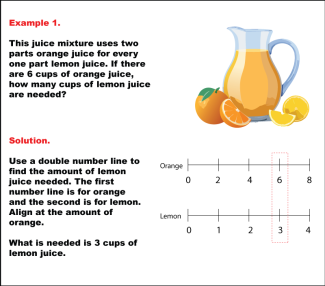
|
Math Example: Ratios with Double Number Lines: Example 1 |
Math Example: Ratios with Double Number Lines: Example 1TopicRatios DescriptionThis example demonstrates the use of double number lines to solve a ratio problem involving orange and lemon juice. The juice mixture uses a ratio of 2 parts orange juice to 1 part lemon juice. Given 6 cups of orange juice, students are asked to determine the amount of lemon juice needed. The solution involves aligning the double number lines at the amount of orange juice and reading the corresponding amount of lemon juice, which is 3 cups. |
Ratios and Rates |
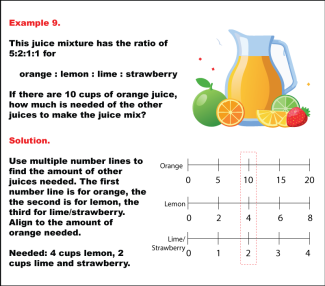
|
Math Example: Ratios with Double Number Lines: Example 10 |
Math Example: Ratios with Double Number Lines: Example 10TopicRatios DescriptionThis example introduces a four-part ratio of 5:2:1:1 for orange, lemon, lime, and strawberry juice. Given 10 cups of orange juice, students need to determine the amounts of lemon, lime, and strawberry juice required. The solution shows that 4 cups of lemon juice and 2 cups each of lime and strawberry juice are needed to maintain the ratio. |
Ratios and Rates |
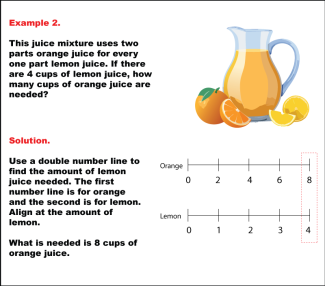
|
Math Example: Ratios with Double Number Lines: Example 2 |
Math Example: Ratios with Double Number Lines: Example 2TopicRatios DescriptionThis example builds upon the previous one, using the same ratio of 2 parts orange juice to 1 part lemon juice. However, in this case, students are given 4 cups of lemon juice and asked to determine the amount of orange juice needed. The solution involves aligning the double number lines at the amount of lemon juice and reading the corresponding amount of orange juice, which is 8 cups. |
Ratios and Rates |
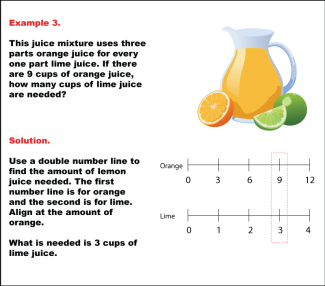
|
Math Example: Ratios with Double Number Lines: Example 3 |
Math Example: Ratios with Double Number Lines: Example 3TopicRatios DescriptionThis example introduces a new ratio of 3 parts orange juice to 1 part lime juice. Students are given 9 cups of orange juice and asked to determine the amount of lime juice needed. The solution involves using a double number line to align at the amount of orange juice and find the corresponding amount of lime juice, which is 3 cups. |
Ratios and Rates |

|
Math Example: Ratios with Double Number Lines: Example 4 |
Math Example: Ratios with Double Number Lines: Example 4TopicRatios DescriptionThis example introduces a more complex ratio of 3 parts orange juice to 2 parts lime juice. Students are given 4 cups of lime juice and asked to determine the amount of orange juice needed. The solution involves using a double number line to align at the amount of lime juice and find the corresponding amount of orange juice, which is 6 cups. |
Ratios and Rates |
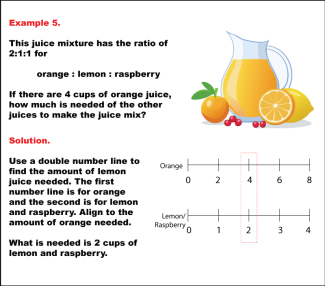
|
Math Example: Ratios with Double Number Lines: Example 5 |
Math Example: Ratios with Double Number Lines: Example 5TopicRatios DescriptionThis example introduces a three-part ratio of 2:1:1 for orange, lemon, and raspberry juice. Given 4 cups of orange juice, students need to determine the amounts of lemon and raspberry juice required. The solution shows that 2 cups each of lemon and raspberry juice are needed to maintain the ratio. |
Ratios and Rates |
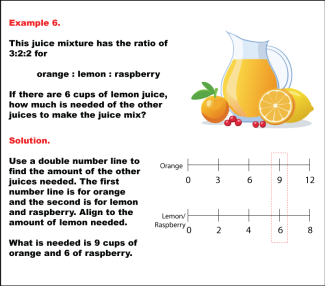
|
Math Example: Ratios with Double Number Lines: Example 6 |
Math Example: Ratios with Double Number Lines: Example 6TopicRatios DescriptionThis example presents a three-part ratio of 3:2:2 for orange, lemon, and raspberry juice. Given 6 cups of lemon juice, students need to determine the amounts of orange and raspberry juice required. The solution shows that 9 cups of orange juice and 6 cups of raspberry juice are needed to maintain the ratio. |
Ratios and Rates |
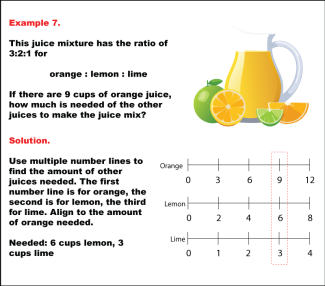
|
Math Example: Ratios with Double Number Lines: Example 7 |
This is part of a series of math examples that show how to solve ratio problems involving double number lines. Note: The download is a PNG file. |
Ratios and Rates |

|
Math Example: Ratios with Double Number Lines: Example 8 |
Math Example: Ratios with Double Number Lines: Example 8TopicRatios DescriptionThis example presents a three-part ratio of 4:3:2 for orange, lemon, and lime juice. Given 4 cups of lime juice, students need to determine the amounts of orange and lemon juice required. The solution shows that 8 cups of orange juice and 6 cups of lemon juice are needed to maintain the ratio. |
Ratios and Rates |
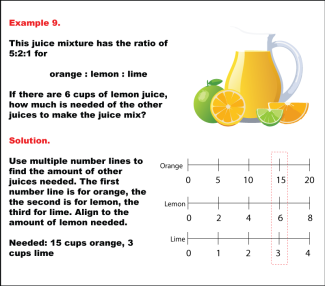
|
Math Example: Ratios with Double Number Lines: Example 9 |
Math Example: Ratios with Double Number Lines: Example 9TopicRatios DescriptionThis example features a three-part ratio of 5:2:1 for orange, lemon, and lime juice. Given 6 cups of lemon juice, students need to determine the amounts of orange and lime juice required. The solution demonstrates that 15 cups of orange juice and 3 cups of lime juice are needed to maintain the ratio. |
Ratios and Rates |

|
Video Transcript: Ratios: Equivalent Ratios |
Video Transcript: Ratios: Equivalent Ratios
What Are Ratios?A ratio is the relationship between two or more quantities among a group of items. |
Ratios and Rates |
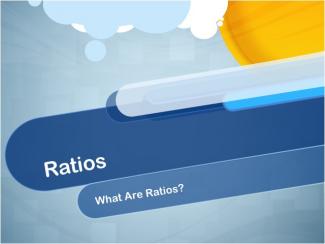
|
Video Tutorial: Ratios, Video 1 |
Video Tutorial: Ratios, Video 1
TopicRatios DescriptionThis video introduces the concept of ratios, which describe relationships between quantities. Key concepts include writing ratios in different forms (e.g., 2:3, 2/3, and 2 to 3) and simplifying ratios. It also covers part-to-part ratios and part-to-whole ratios using examples like sports balls and colored shapes. Applications include categorizing objects and exploring numerical relationships in sets. |
Ratios and Rates |
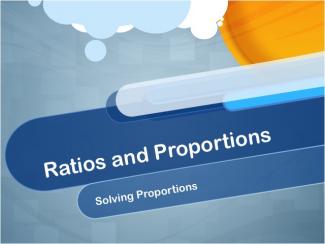
|
Video Tutorial: Ratios, Video 11 |
Video Tutorial: Ratios, Video 11
TopicRatios DescriptionThis video focuses on solving proportions algebraically, converting them into equations to solve real-world problems. Examples include predator-prey ratios, scaling pizza dough recipes, and creating shades of paint. The video demonstrates methods for handling terms in denominators and simplifying ratios to whole numbers. |
Ratios and Rates |
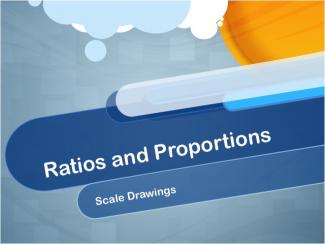
|
Video Tutorial: Ratios, Video 12 |
Video Tutorial: Ratios, Video 12
TopicRatios DescriptionThe video explains how proportions are used to create scale drawings, ensuring geometric figures remain proportional. Examples include finding dimensions in similar triangles, scaling architectural models, and solving geometric problems. The concept of proportional relationships is key to accurate scaling. |
Ratios and Rates |

|
Video Tutorial: Ratios, Video 13 |
Video Tutorial: Ratios, Video 13
TopicRatios DescriptionThis video demonstrates calculating rates from data sets, focusing on patterns like distance-time relationships and wages. Examples include determining car speeds, hourly wages, and unit costs of gasoline. Data tables are used to visualize and compute rates. |
Ratios and Rates |
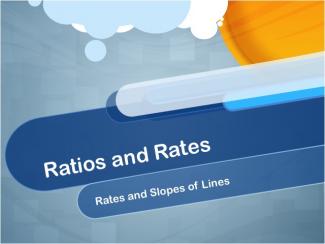
|
Video Tutorial: Ratios, Video 14 |
Video Tutorial: Ratios, Video 14
TopicRatios DescriptionRates are linked to slopes in linear functions. The video explores calculating rates of change for graphs of speed, savings growth, and loan repayment. It highlights using the slope formula to interpret and solve practical problems. |
Ratios and Rates |
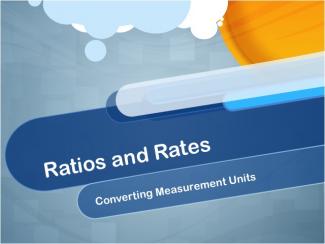
|
Video Tutorial: Ratios, Video 15 |
Video Tutorial: Ratios, Video 15
TopicRatios DescriptionThis video covers converting units using rates, with examples like speed conversion, currency exchange, and calculating seconds in a year. It emphasizes multiplication by conversion rates to transition between units effectively. |
Ratios and Rates |
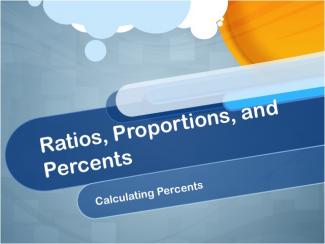
|
Video Tutorial: Ratios, Video 16 |
Video Tutorial: Ratios, Video 16
TopicRatios DescriptionRatios are connected to percentages in this video. Examples include finding percentages of items in collections. It develops a formula for converting part-to-whole ratios into percentages. Relevance to the Topic: This video is a crucial resource for understanding the concept of Ratios. It delves into mathematical foundations by exploring how ratios function in real-life scenarios, such as scaling, comparisons, or visual representations. The mathematical principles demonstrated include proportional reasoning, equivalence, and fraction comparisons. |
Ratios and Rates |